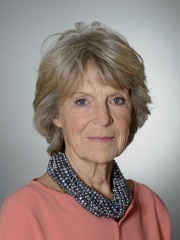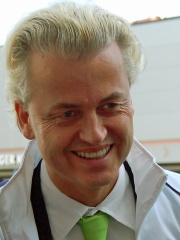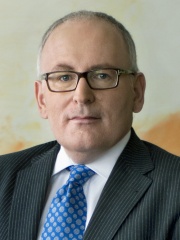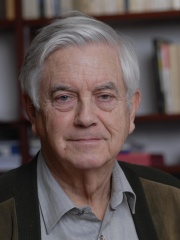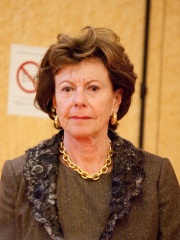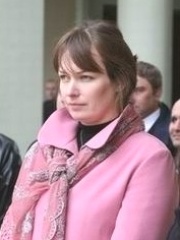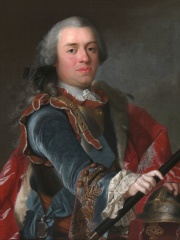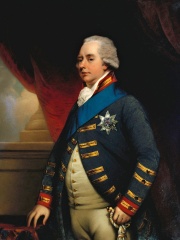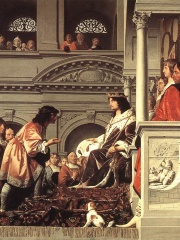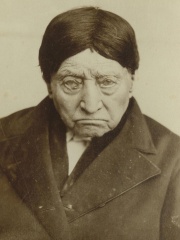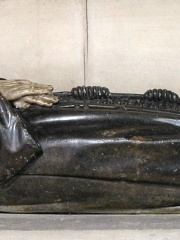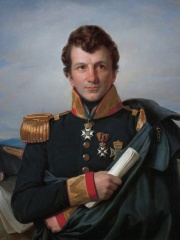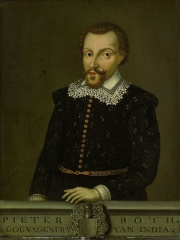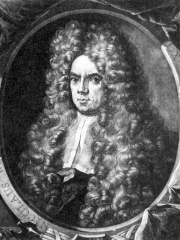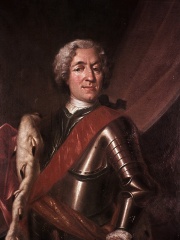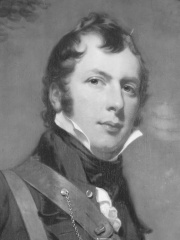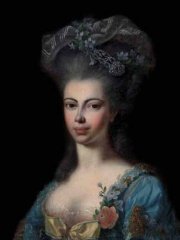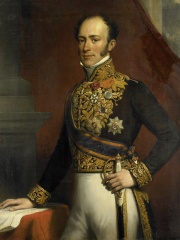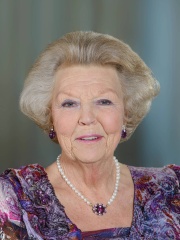
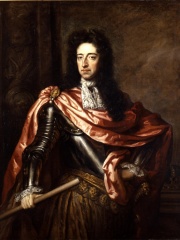
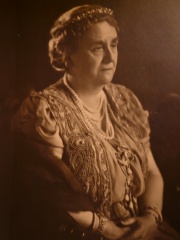
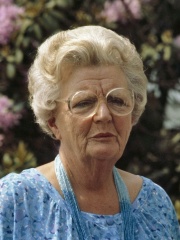
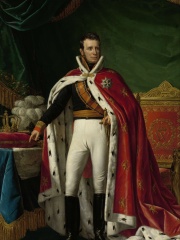
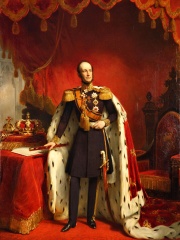
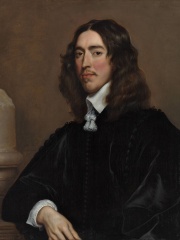
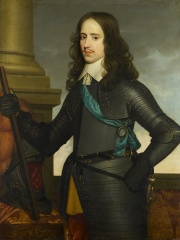
The Most Famous
POLITICIANS from Netherlands
This page contains a list of the greatest Dutch Politicians. The pantheon dataset contains 15,577 Politicians, 147 of which were born in Netherlands. This makes Netherlands the birth place of the 23rd most number of Politicians behind Romania and Hungary.
Top 10
The following people are considered by Pantheon to be the top 10 most legendary Dutch Politicians of all time. This list of famous Dutch Politicians is sorted by HPI (Historical Popularity Index), a metric that aggregates information on a biography’s online popularity. Visit the rankings page to view the entire list of Dutch Politicians.

1. Beatrix of the Netherlands (1938 - )
With an HPI of 76.26, Beatrix of the Netherlands is the most famous Dutch Politician. Her biography has been translated into 91 different languages on wikipedia.
Beatrix (Beatrix Wilhelmina Armgard, Dutch pronunciation: [ˈbeːjaːtrɪks ˌʋɪlɦɛlˈminaː ˈʔɑr(ə)mɡɑrt] ; born 31 January 1938) is a member of the Dutch royal house who reigned as Queen of the Netherlands from 1980 until her abdication in 2013. Beatrix was born during the reign of her maternal grandmother, Queen Wilhelmina, and became heir presumptive upon the accession of her mother, Queen Juliana, in 1948. Beatrix attended a public primary school in Canada during World War II, and then finished her primary and secondary education in the Netherlands in the post-war period. In 1961, she received her law degree from Leiden University. In 1966, Beatrix married Claus von Amsberg, a German diplomat, with whom she had three children. When her mother abdicated on 30 April 1980, Beatrix succeeded her as queen. Beatrix's reign saw the country's Caribbean possessions reshaped with Aruba's secession and becoming its own constituent country within the kingdom in 1986. This was followed by the dissolution of the Netherlands Antilles in 2010, which created the new special municipalities of Bonaire, Sint Eustatius, and Saba, and the two new constituent countries of Curaçao and Sint Maarten. On Koninginnedag (Queen's Day), 30 April 2013, Beatrix abdicated in favour of her eldest son, Willem-Alexander. At the time of her abdication at age 75, Beatrix was the oldest reigning monarch in the country's history.

2. William III of England (1650 - 1702)
With an HPI of 74.02, William III of England is the 2nd most famous Dutch Politician. His biography has been translated into 76 different languages.
William III (William Henry; Dutch: Willem Hendrik; 4 November 1650 – 8 March 1702), also widely known as William of Orange, was the sovereign Prince of Orange from birth, Stadtholder of Holland, Zeeland, Utrecht, Guelders, and Overijssel in the Dutch Republic from the 1670s, and King of England, Ireland, and Scotland from 1689 until his death in 1702. As King of Scotland, he is known as William II. He ruled Britain and Ireland alongside his wife, Queen Mary II, and their joint reign is known as that of William and Mary. William was the only child of William II, Prince of Orange, and Mary, Princess Royal, the daughter of King Charles I of England, Scotland, and Ireland. His father died a week before his birth, making William III the prince of Orange from birth. In 1677, he married his first cousin Mary, the eldest daughter of his maternal uncle James, Duke of York, the younger brother and later successor of King Charles II. A Protestant, William participated in several wars against the powerful Catholic French ruler Louis XIV in coalition with both Protestant and Catholic powers in Europe. Many Protestants heralded William as a champion of their faith. In 1685, his Catholic uncle and father-in-law, James, became king of England, Scotland, and Ireland. James's reign was unpopular with the Protestant majority in Britain, who feared a revival of Catholicism. Supported by a group of influential British political and religious leaders, William invaded England in what became known as the Glorious Revolution. In 1688, he landed at the south-western English port of Brixham; James was deposed shortly afterward. William's reputation as a staunch Protestant enabled him and his wife to take power. During the early years of his reign, William was occupied abroad with the Nine Years' War (1688–1697), leaving Mary to govern Britain alone. She died in 1694. In 1696 the Jacobites, a faction loyal to the deposed James, plotted unsuccessfully to assassinate William and restore the deposed James to the throne. William's lack of children and the death in 1700 of his nephew the Duke of Gloucester, the son of his sister-in-law Anne, threatened the Protestant succession. The danger was averted by placing William and Mary's cousins, the Protestant Hanoverians, in line to the throne after Anne with the Act of Settlement 1701. Upon his death in 1702, William was succeeded in Britain by Anne and as titular Prince of Orange by his cousin John William Friso.

3. Wilhelmina of the Netherlands (1880 - 1962)
With an HPI of 72.28, Wilhelmina of the Netherlands is the 3rd most famous Dutch Politician. Her biography has been translated into 62 different languages.
Wilhelmina (Dutch pronunciation: [ʋɪlɦɛlˈminaː] ; Wilhelmina Helena Pauline Maria; 31 August 1880 – 28 November 1962) was Queen of the Netherlands from 1890 until her abdication in 1948. She reigned for nearly 58 years, making her the longest-reigning monarch in Dutch history, as well as the longest-reigning female monarch outside the United Kingdom. Her reign saw World War I, the Dutch economic crisis of 1933 and World War II. The only surviving child of King William III of the Netherlands and Emma of Waldeck and Pyrmont, Wilhelmina ascended the throne at the age of 10 after her father's death in 1890, under her mother's regency. After taking charge of government, Wilhelmina became generally popular for maintaining Dutch neutrality during the First World War and solving many of her country's industrial problems. By that time, her business ventures had made her the world's first female billionaire in dollars. Following the German invasion of the Netherlands in 1940, Wilhelmina fled to Britain and took charge of the Dutch government-in-exile. She frequently spoke to the nation over radio and came to be regarded as a symbol of the resistance although she was criticised for failing to acknowledge some of the atrocities such as the Bombing of Nijmegen. By 1948, she had returned to the liberated Netherlands and was the only survivor of the 16 monarchs who were sitting on their thrones at the time of her inauguration. Increasingly beset by poor health, Wilhelmina abdicated in favour of her daughter Juliana in September 1948 and retired to Het Loo Palace, where she died in 1962. She remains reasonably popular in the Netherlands, even among the Dutch Republican movement. This is due to her being seen as a symbol of Dutch Resistance during World War II.

4. Juliana of the Netherlands (1909 - 2004)
With an HPI of 72.14, Juliana of the Netherlands is the 4th most famous Dutch Politician. Her biography has been translated into 56 different languages.
Juliana (Dutch pronunciation: [ˌjyliˈjaːnaː]; Juliana Louise Emma Marie Wilhelmina; 30 April 1909 – 20 March 2004) was Queen of the Netherlands from 1948 until her abdication in 1980. Juliana was the only child of Queen Wilhelmina and Prince Henry of Mecklenburg-Schwerin. She received a private education and studied international law at the University of Leiden. In 1937, she married Prince Bernhard of Lippe-Biesterfeld with whom she had four daughters: Beatrix, Irene, Margriet, and Christina. During the German invasion of the Netherlands in the Second World War, the royal family was evacuated to the United Kingdom. Juliana then relocated to Canada with her children, while Wilhelmina and Bernhard remained in Britain. The royal family returned to the Netherlands after its liberation in 1945. Due to Wilhelmina's failing health, Juliana took over royal duties briefly in 1947 and 1948. In September 1948, Wilhelmina abdicated and Juliana ascended to the Dutch throne. Her reign saw the decolonization and independence of the Dutch East Indies (now Indonesia) and Suriname. Despite a series of controversies involving the royal family, Juliana remained a popular figure among the Dutch. In April 1980, Juliana abdicated in favour of her eldest daughter, Beatrix. Upon her death in 2004 at the age of 94, she was the longest-lived former reigning monarch in the world.
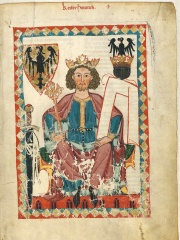
5. Henry VI, Holy Roman Emperor (1165 - 1197)
With an HPI of 71.39, Henry VI, Holy Roman Emperor is the 5th most famous Dutch Politician. His biography has been translated into 52 different languages.
Henry VI (German: Heinrich VI.; November 1165 – 28 September 1197), a member of the Hohenstaufen dynasty, was King of Germany (King of the Romans) from 1169 and Holy Roman Emperor from 1191 until his death. From 1194 he was also King of Sicily. Henry was the second son of Emperor Frederick Barbarossa and Beatrice I, Countess of Burgundy. Well educated in the Latin language, as well as Roman and canon law, Henry was also a patron of poets and a skilled poet himself. In 1186 he was married to Constance of Sicily, the posthumous daughter of the Norman king Roger II of Sicily. Henry, stuck in the Hohenstaufen conflict with the House of Welf until 1194, had to enforce the inheritance claims by his wife against her nephew Count Tancred of Lecce. Henry's attempt to conquer the Kingdom of Sicily failed at the siege of Naples in 1191 due to an epidemic, with Empress Constance captured. Based on an enormous ransom for the release and submission of King Richard I of England, he conquered Sicily in 1194; however, the intended unification with the Holy Roman Empire ultimately failed due to the opposition of the Papacy. In Sicily, Henry had a reputation for ruthless suppression of political opponents. Until this day, he is sometimes given the nickname "the Cruel" (il crudele) by Italian historiography. Henry threatened to invade the Byzantine Empire after 1194 and succeeded in extracting a ransom, the Alamanikon, from Emperor Alexios III Angelos in return for cancelling the invasion. He made the Kingdom of Cyprus and the Armenian Kingdom of Cilicia formal subjects of the empire and compelled Tunis and Tripolitania to pay tribute to him. In 1195 and 1196, he attempted to turn the Holy Roman Empire from an elective to a hereditary monarchy, the so-called Erbreichsplan, but met strong resistance from the prince-electors. Henry pledged to go on crusade in 1195 and began preparations. A revolt in Sicily was crushed in 1197. The Crusaders set sail for the Holy Land that same year but Henry died of illness at Messina on 28 September 1197 before he could join them. His death plunged the Empire into the chaos of the German throne dispute for the next 17 years.

6. William I of the Netherlands (1772 - 1843)
With an HPI of 70.95, William I of the Netherlands is the 6th most famous Dutch Politician. His biography has been translated into 54 different languages.
William I (Willem Frederik; 24 August 1772 – 12 December 1843) was king of the Netherlands and grand duke of Luxembourg from 1815 until his abdication in 1840. William was the son of William V, Prince of Orange, the last stadtholder of the Dutch Republic, and Wilhelmina of Prussia. During the Flanders campaign, he commanded the Dutch troops and fought against the French invasion. The family went into exile in London in 1795 following the Batavian Revolution. As compensation for the loss of his father's possessions in the Low Countries, William was appointed ruler of the newly created Principality of Nassau-Orange-Fulda in 1803. When Napoleon invaded Germany in 1806, William fought on the Prussian side and was deposed upon French victory. With the death of his father in 1806, he became Prince of Orange and ruler of the Principality of Orange-Nassau, which he also lost the same year after the dissolution of the Holy Roman Empire and subsequent creation of the Confederation of the Rhine. He spent the following years in exile in Prussia. In 1813, following Napoleon's defeat at Leipzig, the Orange-Nassau territories were restored to William; he also accepted the offer to become Sovereign Prince of the United Netherlands. William proclaimed himself king of the Netherlands in 1815. In the same year, he concluded a treaty with King Frederick William III in which he ceded the Orange-Nassau to Prussia in exchange for becoming the new grand duke of Luxembourg. As king, he adopted a new constitution, presided over strong economic and industrial progress, promoted trade and founded the universities of Leuven, Ghent and Liège. The imposition of the Reformed faith and the Dutch language, as well as feelings of economic inequity, caused widespread resentment in the southern provinces and led to the outbreak of the Belgian Revolution in 1830. William failed to crush the rebellion and in 1839 he accepted the independence of Belgium in accordance with the Treaty of London. William's disapproval of changes to the constitution, the loss of Belgium and his intention to marry Henrietta d'Oultremont, a Roman Catholic, led to his decision to abdicate in 1840. His eldest son acceded to the throne as King William II. William died in 1843 in Berlin at the age of 71.

7. William II of the Netherlands (1792 - 1849)
With an HPI of 68.80, William II of the Netherlands is the 7th most famous Dutch Politician. His biography has been translated into 55 different languages.
William II (Dutch: Willem Frederik George Lodewijk; English: William Frederick George Louis; 6 December 1792 – 17 March 1849) was King of the Netherlands, Grand Duke of Luxembourg, and Duke of Limburg. William II was the son of William I and Wilhelmine of Prussia. When his father, who up to that time ruled as sovereign prince, proclaimed himself king in 1815, he became Prince of Orange as heir apparent of the United Kingdom of the Netherlands. With the abdication of his father on 7 October 1840, William II became king. During his reign, the Netherlands became a parliamentary democracy with the new constitution of 1848. William II was married to Anna Pavlovna of Russia. They had four sons and one daughter. William II died on 17 March 1849 and was succeeded by his son William III.

8. Johan de Witt (1625 - 1672)
With an HPI of 67.63, Johan de Witt is the 8th most famous Dutch Politician. His biography has been translated into 37 different languages.
Johan de Witt (Dutch pronunciation: [ˈjoːɦɑn də ˈʋɪt]; 24 September 1625 – 20 August 1672), Lord of Zuid- en Noord-Linschoten, Snelrewaard, Hekendorp en IJsselvere, was a Dutch statesman and a major political figure in the Dutch Republic in the mid-17th century, the First Stadtholderless Period, when its flourishing sea trade in a period of global colonisation made the republic a leading European trading and seafaring power – now commonly referred to as the Dutch Golden Age. De Witt was elected Grand pensionary of Holland, and together with his uncle Cornelis de Graeff, he controlled the Dutch political system from around 1650 until the Rampjaar (Disaster Year) of 1672. This progressive cooperation between the two statesmen, and the consequent support of Amsterdam under the rule of De Graeff, was an important political axis that organized the political system within the republic. As a leading republican of the Dutch States Party, De Witt opposed the House of Orange-Nassau and the Orangists and preferred a shift of power from the central government to the regenten. However, his neglect of the Dutch States Army (as the regents focused mainly on the navy, thinking they could avoid land wars) proved disastrous when the Dutch Republic suffered numerous early defeats in the Rampjaar. In the hysteria that followed the effortless invasion by an alliance of England, France and some German states, he and his brother Cornelis de Witt were blamed and lynched in The Hague, with their corpses at least partially eaten by the rioters. These cannibals were never prosecuted, and some historians claim William of Orange may have incited them.

9. William II, Prince of Orange (1626 - 1650)
With an HPI of 66.48, William II, Prince of Orange is the 9th most famous Dutch Politician. His biography has been translated into 37 different languages.
William II (Dutch: Willem II van Oranje-Nassau; 27 May 1626 – 6 November 1650) was sovereign Prince of Orange and Stadtholder of Holland, Zeeland, Utrecht, Guelders, Overijssel and Groningen in the United Provinces of the Netherlands from 14 March 1647 until his death three years later. His only child, William III, reigned as King of England, Ireland, and Scotland.
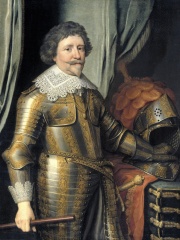
10. Frederick Henry, Prince of Orange (1584 - 1647)
With an HPI of 65.95, Frederick Henry, Prince of Orange is the 10th most famous Dutch Politician. His biography has been translated into 36 different languages.
Frederick Henry (Dutch: Frederik Hendrik; 29 January 1584 – 14 March 1647) was the sovereign prince of Orange and stadtholder of Holland, Zeeland, Utrecht, Guelders, Overijssel in the Dutch Republic from 1625 until his death in 1647. In the last seven years of his life, he was also the stadtholder of Groningen (1640-1647). As the leading soldier in the Dutch wars against Spain, his main achievement was the successful Siege of 's-Hertogenbosch in 1629. It was the main Spanish base and a well-fortified city protected by an experienced Spanish garrison and by formidable water defenses. His strategy was the successful neutralization of the threat of inundation of the area around 's-Hertogenbosch' and his capture of the Spanish storehouse at Wesel. The successful sieges under his command earned him the epithet ‘city forcer’ (Dutch: stedendwinger).
Pantheon has 147 people classified as politicians born between 875 and 1998. Of these 147, 44 (29.93%) of them are still alive today. The most famous living politicians include Beatrix of the Netherlands, Mark Rutte, and Jaap de Hoop Scheffer. The most famous deceased politicians include William III of England, Wilhelmina of the Netherlands, and Juliana of the Netherlands. As of April 2022, 30 new politicians have been added to Pantheon including Geert Adriaans Boomgaard, Philippa of Guelders, and Anna van Egmont.
Living Politicians
Go to all Rankings
Beatrix of the Netherlands
1938 - Present
HPI: 76.26
Mark Rutte
1967 - Present
HPI: 61.29
Jaap de Hoop Scheffer
1948 - Present
HPI: 60.10
Princess Irene of the Netherlands
1939 - Present
HPI: 60.00
Geert Wilders
1963 - Present
HPI: 55.97
Jan Peter Balkenende
1956 - Present
HPI: 55.87
Frans Timmermans
1961 - Present
HPI: 55.13
Roméo Dallaire
1946 - Present
HPI: 51.38
Frits Bolkestein
1933 - Present
HPI: 50.24
Badr Hari
1984 - Present
HPI: 49.81
Neelie Kroes
1941 - Present
HPI: 49.08
Sandra Roelofs
1968 - Present
HPI: 49.00

Deceased Politicians
Go to all Rankings
William III of England
1650 - 1702
HPI: 74.02
Wilhelmina of the Netherlands
1880 - 1962
HPI: 72.28
Juliana of the Netherlands
1909 - 2004
HPI: 72.14
Henry VI, Holy Roman Emperor
1165 - 1197
HPI: 71.39
William I of the Netherlands
1772 - 1843
HPI: 70.95
William II of the Netherlands
1792 - 1849
HPI: 68.80
Johan de Witt
1625 - 1672
HPI: 67.63
William II, Prince of Orange
1626 - 1650
HPI: 66.48
Frederick Henry, Prince of Orange
1584 - 1647
HPI: 65.95
William IV, Prince of Orange
1711 - 1751
HPI: 65.59
William V, Prince of Orange
1748 - 1806
HPI: 65.48
William II of Holland
1228 - 1256
HPI: 61.64

Newly Added Politicians (2022)
Go to all Rankings
Geert Adriaans Boomgaard
1788 - 1899
HPI: 55.63
Philippa of Guelders
1464 - 1547
HPI: 54.41
Anna van Egmont
1533 - 1558
HPI: 53.31
Johannes van den Bosch
1780 - 1844
HPI: 53.13
Pieter Both
1568 - 1615
HPI: 52.72
Nicolaes Witsen
1641 - 1717
HPI: 51.47
Wilhelm Heinrich, Duke of Saxe-Eisenach
1691 - 1741
HPI: 49.29
Gerrit Schimmelpenninck
1794 - 1863
HPI: 48.99
Landgravine Juliane of Hesse-Philippsthal
1761 - 1799
HPI: 48.70
Pieter van Vollenhoven
1939 - Present
HPI: 48.65
Jan Jacob Rochussen
1797 - 1871
HPI: 47.86
Sigrid Kaag
1961 - Present
HPI: 47.48

Which Politicians were alive at the same time? This visualization shows the lifespans of the 25 most globally memorable Politicians since 1700.



